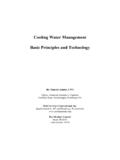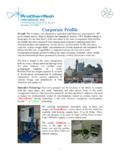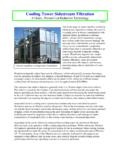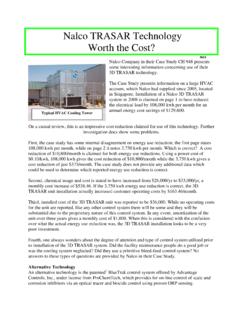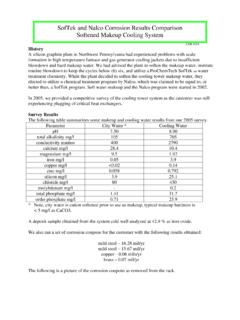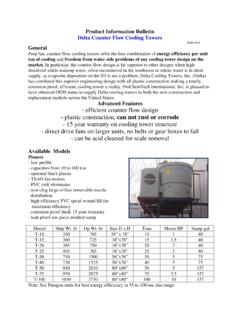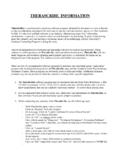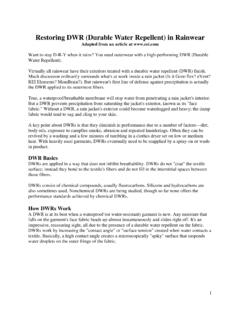Transcription of Case History Report The “Dolphin” Nonchemical …
1 1 Case History Report The Dolphin Nonchemical Device Cooling Towers Device Evaluated This is our second case History Report on "The Dolphin HYTRONIC Series 1000" pulsed power water treatment device (Dolphin) manufactured by Clearwater Systems LLC, 145 Dennison Rd., Box 463, Essex, CT 06426, ph: 860-767-0850 FAX 860-767-8972 WEB System Data Clearwater representatives designed a water treatment program, based on Dolphin non-chemical devices (NCD), for treatment of a new, large cooling tower/chiller system at a Pennsylvania convention center. At the time of our site review, the system had been in operation approximately 1 1/2 years and the operators were planning to convert to a standard chemical water management program within a month. Cooling Towers Four (4) galvanized steel construction, 1500 ton capacity, BAC 3000 series cross flow cooling towers, installed in banks of two (East and West), are used to provide cooling for the condensers of four freon cycle chillers.
2 Typical load is two units base, two units in reserve. System metallurgy is black iron piping, copper tubes, and some brass valves. Dolphin units are installed on each chiller condenser return line (4 units) and the makeup water line (1 unit) to the cooling towers at a reported equipment cost of $120,000. A conductivity based blowdown control was installed for control of concentration cycles while a Lakos hydrocyclone was installed on the cooling tower hot water return line for control of suspended solids. Makeup is normally obtained from an on-site well with City of Pittsburgh water as a backup source. Claims Made Dolphin sales literature and WEB site information claim that the NCD "improves system efficiency - eliminates bio-film - reduces encrustation & fouling - controls bacteria to very low levels - inhibits corrosion" in cooling towers. Dolphin WEB site data, 01/03, claims that Dolphin devices "impart pulsed, high frequency electromagnetic energy into flowing water".
3 No USEPA registration pesticide number has been seen in the Dolphin literature reviewed. Given the claim for control of bacteria and elimination of bio-film, we believe such a registration is required under FIFRA. 2 History The Dolphin units were installed concurrent with construction of the convention center with start-up in April, 2002. Operation was continued through September 15, 2003, date of our review, using only the installed NCD systems as treatment with no pretreatment of the makeup well water. We have since confirmed that the convention center converted to a chemical water management program about one month after our review. Review PCT personnel visited the site on September 15, 2003, to walk the system and examine the cooling towers. The site visit was at the request of operating personnel as they had determined, based on their experience with the NCD systems, to return to a chemical treatment program in the near future.
4 During the visit, plant personnel reported substantial corrosion, scaling, deposition, and algae growth problems. The cooling towers were reported to require frequent manual cleanup to remove algae and slime growth from the decks and fill, while the tube sheets and water boxes of the chiller condensers had been wire brushed to remove rust and deposition. The tubes had been brushed once to remove fouling. Color pictures were supplied of cooling tower algae growth; chiller tube and water box corrosion and deposition; and cooling tower corrosion and deposition. Please note the attached pictures numbered 1 through 4. A Report by Cyrus Rice Water Consultants (CRC), an independent water consultant, on a cooling water system water audit they had undertaken in July, 2003, was also provided to us by the operating personnel. Analytical data from this Report is summarized as follows: Parameter Well water makeup East cooling tower West cooling tower pH conductivity, mmhos 544 1418 1525 total alkalinity, mg/l 140 150 162 calcium, mg/l 84 102 110 chloride, mg/l 96 273 297 silicon, mg/l copper, mg/l < iron, mg/l saturation index + + + 3 Microbiological samples were also taken by CRC with the following results reported.
5 Parameter East cooling tower West cooling tower Planktonic plate count cfu/100 ml 1,100 1,380 Sessile swab sample cfu/ml TNTC TNTC TNTC = to numerous to count Our own inspection of the cooling towers showed algae growth in the basins and scale on the cooling tower fill. A sample of the scale removed from the cooling tower was analyzed at Analytical Services, Inc., a sate certified laboratory, with the following results reported. Parameter Results as % dry weight Parameter Results as % dry weight Loss on ignition Acid insoluble Aluminum as Al2O3 Calcium as CaO Copper as CuO Iron as Fe2O3 Magnesium as MgO Manganese as MnO2 Silicon as SiO2 Sulfate as SO4 Phosphate as PO4 Zinc as ZnO A Dolphin unit control box was opened and found to contain a small transformer. The transformer output, passing through an inductor coil, fed into the actual Dolphin unit.
6 The Dolphin unit was also inspected and appeared to be nothing more than an insulated coil of wire wound around a pipe spool. Typical power input was listed on the literature as 110 to 390 va. Discussion The data in the CRC Report clearly shows that the cooling tower system had a substantial loss of calcium and alkalinity while operating with NCD treatment. True cycles of concentration, based on chlorides, was to cycles, east and west cooling towers respectively, while the alkalinity cycles were only and , and calcium cycles were and Picture 1, which clearly shows calcium scale slough off and some scale still on the cooling tower fill, shows where the calcium and alkalinity went. The analysis of the scale obtained from the cooling tower fill agrees with the water analysis data in that the majority of the scale was calcium carbonate. Picture 3 also shows what appears to be calcium scale on the inside surface of the condenser tubes. We also note that the iron present in the makeup water, mg/l, has also failed to cycle in the cooling water, levels of and being reported in the cooling waters.
7 Given aeration of the cooling waters and the alkaline pH, iron would be expected to precipitate. Looking at pictures 1, 2, and 3; the red coloration of the scale and deposits is likely due to iron. Further, the scale analysis confirms the presence of iron at % 4 Again referencing picture 3, it appears that the tube sheet is suffering from rather extensive corrosion as indicated by the presence of rusty areas. This was further confirmed by operating personnel reporting pits in the tube sheet when it was cleaned of deposits. Looking at the water analysis data, we also see that the level of copper in both cooling towers is substantially elevated over what would be expected based upon cycling of the makeup water. This is a good indication that corrosion of the copper tubes in the condenser was a problem. The low microorganism planktonic plate count found was not a surprise. Given the obvious calcium precipitation within the system, removal of microorganisms from the cooling water by simple flocculation could be expected.
8 Flocculation is the chemical process commonly used in many potable water treatment plants and has nothing to do with "operation" of the NCD, being simply a precipitation of calcium carbonate when the concentration present in the water exceeds its solubility limit. The high sessile microorganism level reported is visually confirmed by picture 4, showing substantial algae growth, and our own observations. The high level of sessile microorganisms found is of great concern due to both under deposit corrosion and the effects when these organisms slough off. Such organism masses are an ideal place for legionella bacteria to multiply and they would become dispersed throughout the water during sloughing events, and thus able to enter the cooling tower windage stream. Conclusions Based on the analytical data and observed corrosion, it is evident that the Dolphin NCD does not control corrosion in a cooling water environment.
9 The analytical data and scale observed prove that the Dolphin NCD does not provide an acceptable level of scale control when a moderate hardness water is used as makeup. Substantial scale formation within the cooling tower fill was observed and picture 3 shows scale formation within the condenser tubes. While the CRC Report noted that planktonic microorganisms were at low numbers, the very high levels of sessile microorganisms found is completely unacceptable for operation of a cooling water system. Based on the high levels of sessile microorganisms reported and observed, it is clearly evident that the Dolphin NCD has no effect on biofilms. We are also of the opinion that the low level of planktonic microorganisms is due solely to flocculation, with subsequent removal in the hydrocyclone, resultant from calcium precipitation within the cooling water. Literature Review of the supplied literature and Clearwater WEB site shows no theory of operation for the Dolphin NCD which is consistent with accepted scientific principals.
10 5 For instance, reference is made to Faraday's Law of Magnetic Induction (1) to "explain" how the Dolphin unit "effects surface charge and precipitation". This law concerns induction of an electrical voltage via movement of a magnetic field relative to a conductor. At no place in the equation for this law, EMF = -lambda X (dif magnetic flux/dif time), can one find an addition, or removal, of an electron to a particle, which would be required to effect surface charge. Dolphin literature further states operation is via "The electric field effects the surface charge and precipitation behavior of charged particles--". It is a commonly accepted chemical principal that the constituents responsible for scale formation exist in water as separate, hydrated ions, not as "charged particles". Since there are no particles in the water to be "effected" by an electric field, there will be no action by the NCD. The claimed "activation of colloidal nucleation sites" resulting in bulk water precipitation of calcium carbonate is easily explained by well known chemical processes, operating with, or without, the presence of the Dolphin NCD.
